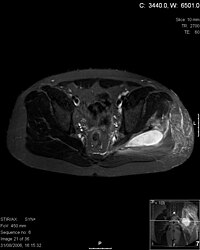
Photo from wikipedia
RATIONALE Pyomyositis is characterized by an insidious and multifactorial inflammatory process, which is often caused by hematogenous pathogen. Predisposing risk factors include immunodeficiency, diabetes, malignancy, or trauma. The spectrum of… Click to show full abstract
RATIONALE Pyomyositis is characterized by an insidious and multifactorial inflammatory process, which is often caused by hematogenous pathogen. Predisposing risk factors include immunodeficiency, diabetes, malignancy, or trauma. The spectrum of clinical presentation depends on disease severity, typically presented by fever and hip pain. We hereby present a case with extensive pyomyositis secondary to chronic paronychia infection. PATIENT CONCERNS A 14-year-old immunocompetent male presented with fever and hip pain. The patient was initially surveyed for common infectious etiologies prior to the presentation of acute limping, which led to image confirmation of extensive pyomyositis. DIAGNOSIS The patient presented with acute pain in the right hip accompanied by headache, myalgia of the right leg, and intermittent fever for a week. Physical examination disclosed limping gait, limited range of motion marked by restricted right hip flexion and right knee extension, and chronic paronychia with a nail correction brace of the left hallux. Diagnosis of pyomyositis was confirmed by magnetic resonance image. Methicillin-resistant strains of Staphylococcus aureus was isolated from the patient's blood and urine cultures within 2 days of collection. The same strain was also isolated from the pus culture collected via sonography-guided aspiration. INTERVENTIONS Antibiotics treatment with oxacillin, teicoplanin, daptomycin, and fosfomycin were administered. Sonography-guided aspiration and computed tomography-guided pigtail drainage were arranged, along with nail extraction of his left hallux paronychia prior to discharge. Oral antibiotics fusidic acid was prescribed. Total antibiotics course of treatment was 4 weeks. OUTCOMES The patient gradually defervesced and was afebrile after drainage. Followed limb doppler sonography showed regression of the abscess at his right lower limb. Gait and range of motion gradually recovered without sequelae. LESSONS Ambulation and quality of life are greatly affected by the inflammatory process of pyomyositis. Detailed evaluation of predisposing factors should be done, even in immunocompetent individuals. Timely diagnosis is vital to successful treatment.
Journal Title: Medicine
Year Published: 2022
Link to full text (if available)
Share on Social Media: Sign Up to like & get
recommendations!